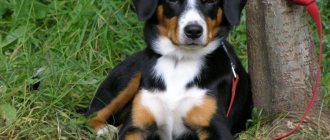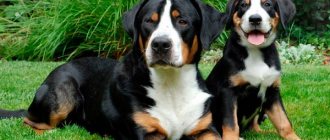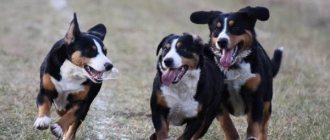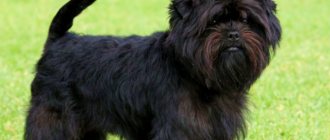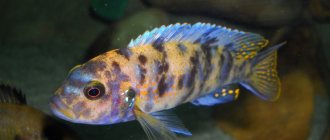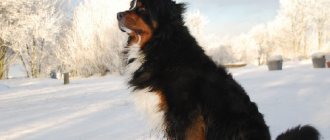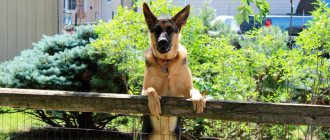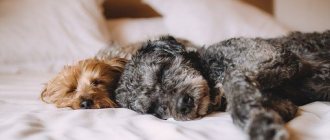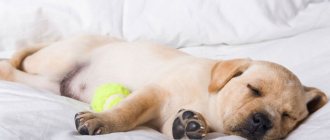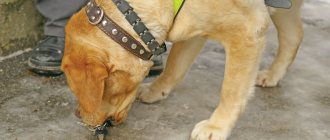Story
The literal translation of the name “Bernese Mountain Dog” is “a dog from the Alpine meadows.” Indeed, this breed was known in the Swiss mountains back in the first century AD - it was then that the Romans brought their dogs - huge Molossians - to Helvetia. Some of them were lost and, as a result of crossing with other breeds - Great Danes and the Central European Great Dane - the Mountain Dogs appeared. Swiss peasants quickly appreciated this breed - the dogs were both strong and friendly - and began to breed them to help with housework.
Bernese Mountain Dogs have taken root on Swiss farms. They helped herd and guard livestock. A large, fluffy and friendly dog did not scare the sheep and at the same time could give a proper rebuff to predators. Sennenhunds were often used as guard dogs; they guarded yards. These animals were also used as heavy haulers: the Sennenhund could easily pull a cart.
The breed began to be purposefully bred in 1892, when winemaker F. Shertenleib bought several animals and began crossing them with each other. The FCI officially recognized the breed in 1993.
Currently, Mountain Dogs work in mountain rescue teams, but more often they are kept as companions and pets.
History of the breed
The Bernese Shepherd is considered one of the oldest breeds. Mentions of such animals can be found in the works of ancient Roman historians. For several centuries, dogs were used as guards and shepherds. Hardy and strong animals were incredibly devoted to their owners. In the Middle Ages, when peasants could suffer from wandering robbers, and livestock from wild animals, the Bernese Shepherd Dog was an indispensable friend and helper for humans. People even made up legends about Sennehunds. The animals are so strong that their owners even used them to transport small loads.
Today, the Bernese Shepherd is a wonderful family companion, pet and guard.
Dogs of this breed were first demonstrated in 1902 at an exhibition in Bern. Thanks to its excellent character, beautiful appearance and excellent health, the new breed very quickly won the hearts of dog connoisseurs in Switzerland. Germany and Austria, and then throughout Europe. In 1907, the first club was founded in Switzerland, uniting Bernese Shepherd breeders. The modern name of the breed, translated from German, means nothing more than “Bernese prairie dog”. In Russia, such animals were first registered in the late eighties. And in 1995, the first Russian club called “Bernese Mountain Dog” was formed in Moscow.
Description of the breed with photos
The Bernese Mountain Dog is a large and beautiful dog, somewhat reminiscent of its exterior. Its highlight is its thick, long and curly fur, which you just want to stroke. By the way, Mountain Dogs are friendly and usually do not refuse such affection.
Color
Most often, Mountain Dogs are tri-colored, with the main color being black. Near the eyes and on the tail there are red, or rather brownish-red, inclusions, and between the eyes, on the chest and tail there are white ones. Sometimes the entire chest, as well as the paws, are white. However, a primary color other than black is considered a disqualifying fault .
Appearance - standard
Main points on the breed standard:
- This is a strong and agile working dog, stocky rather than elongated, harmonious and balanced. The ratio of body length and height at the withers should be 10:9.
- The tail is fluffy, reaching to the hock joint. When calm, it hangs down, and when excited and moving, the dog can lift it slightly above the level of the back.
- The head is strong, of medium length; the skull in profile and when viewed from the front should be slightly convex, and the transition to the neck should be pronounced, but not too much. The muzzle is straight. The nose and lips are always black, the bite is full, strong, scissor-shaped. The teeth are white, with incisors located in one line.
- Sennenhunds have dark brown, almond-shaped eyes, and their ears are triangular, medium in size, slightly rounded at the end. The neck is strong and muscular, of medium length, with a powerful scruff, leading into a strong and compact body.
- The chest should be wide, the back should be straight and strong, and the stomach should not be tucked up.
- The forelimbs are straight and parallel to each other, the hind limbs, when viewed from the rear, are straight and parallel to each other, with strong bones and well-developed muscles.
Dimensions: how much does it weigh
Height - for males - 63.5-70 cm, for females - 60-63 cm. The weight of an adult dog is on average approximately 40-44 kg, while males can reach 50 kg, and females - 48.
Height at withers for males - 63.5 - 70 cm, for females - 60 - 63 cm. Weight - 40 - 44 kg.
Weight and height chart:
Weight by month
Puppy weight by month (age):
- 1 month - weight 2.5 - 4.5 kg, height 20 - 25 cm;
- 2 month – weight 6 – 10 kg, height 28 – 36 cm;
- 3 month - weight 11 - 17 kg, height 36 - 44 cm;
- 4 months – weight 15 – 26 kg, height 42 – 51 cm;
- 5-6 months - weight 25 - 38 kg, height 50 - 61 cm;
- 7-8 months - weight 34 - 45 kg, height 55 - 67 cm;
- 9-12 months - weight from 30 to 50 kg, height - 58 - 70 cm. The animal will no longer grow, but over the next few years it can gain up to 4-13 kg of weight.
1 month
2 months
3 months
4 months
Puppy 5 months old in the photo
Photo 6 months
Howl and bark
The bark of Bernese Mountain Dogs is short and sharp. This animal will not bark for no reason, which is why it is valued. But if your pet gives a voice, it’s definitely not without reason, because Bernese are excellent watchdogs.
The breed is not prone to howling, but it is worth teaching your baby Mountain Dog to somehow entertain himself on his own if you are going to leave him alone in the apartment. Otherwise, the animal may discover howling talents that are uncharacteristic for the breed.
17 reasons why a dog howls and instructions on how to stop it
Important proportions
- The body is compact, the ratio of the height at the withers and the length of the body is 9:10
- The ideal ratio of height at the withers and depth of the chest is 2:1
- When looking at a dog, you should not create the impression of short legs or long legs.
- Males must have two normally developed testes, fully descended into the scrotum.
FCI standard No. 45 Origin: Switzerland. Patronage: FCI. Purpose: Shepherd, guard and draft dog on farms, but currently the Bernese Mountain Dog is a domestic and working dog (used for various human needs). FCI Classification: Group 2: Pinscher and Schnauzer, Molosser, Swiss Cattle Dog and other breeds. Section 3: Swiss Cattle Dogs. No operational tests.
| Characteristics | Male | Bitch |
| Height (at withers) | 64-70 cm (ideal: 66-68 cm) | 58-66 cm (ideal: 60-63 cm) |
| Weight | proportional to height | proportional to height |
| Head | The head is not too massive, strong, but the size is in harmony with the appearance. Males have a more massive head than females, with a distinctly masculine expression. | |
| Skull and transition from forehead to muzzle (stop) | The skull is slightly rounded when viewed from the front and in profile. The front groove is almost invisible. The stop is good, but not pronounced. | |
| Muzzle | Medium length, strong and full. The bridge of the nose is straight. | |
| Eyes | Almond-shaped, dark brown. The eyes are not too deep set, not protruding. The eyelids are tight fitting. | |
| Ears | Triangular in shape, flat, set high, medium size. The ends are slightly rounded. When a dog is alert, the back of the ears are raised, and the front edge of the ears is pressed to the head. In a calm state, the ears hang and fit tightly to the head. | |
| Nose | Always black. | |
| Lips | Black lips fit tightly to each other. | |
| Teeth | The jaws are strong and have a scissor bite. A pincer bite is allowed. | |
| Neck | Medium length, strong and muscular. Smoothly transitions to the back. | |
| Frame | The topline falls down from the neck to the withers in a harmonious line, then becomes straight. The back is straight, horizontal, strong. The loin is wide and strong, narrower than the chest when viewed from above. The croup is wide and smoothly rounded. The chest is wide and deep, reaching to the elbows. The front part of the chest is clearly defined. The underline from the chest rises slightly towards the hind legs. The ribs are well rounded, but not barrel-shaped. | |
| Tail | Reaches to the hocks or below. The tail is bushy. At rest, straight and held down. When the dog is in motion, the tail is carried at or slightly above the level of the back. | |
| Forelegs | Straight, parallel, widely spaced. The shoulder blades are strong and long, have a good slope. The shoulder blades are moderately laid back, form not too obtuse angles with the humerus, are well muscled and fit well to the chest. The humerus is sloping and long. The elbows are tightly pressed, neither turned in nor out. Forearms are straight and strong. The pasterns are almost vertical and strong when viewed from the side, and when viewed from the front the pasterns are slightly sloping, in line with the forearms. | |
| Hind limbs | When viewed from behind, the limbs are straight and parallel, the stance is not narrow. The hips are wide, long, strong. The muscles of the thighs are well developed. Knees with distinct angles. The lower legs are long and sloping. The hock joints are strong and well angulated. The hocks are almost vertical, perpendicular to the ground. There are no profitable fingers (mandatory removal, except in countries where this is prohibited) | |
| Paws | The front paws are round and small. The fingers are arched, well assembled, turning neither in nor out. The hind legs are less arched than the front legs and turn neither in nor out. | |
| Wool | Thick, long, straight or slightly wavy, with a natural shine. Tricolor color. The main coat color is black with bright tan markings on the cheekbones, chest, above the eyes and on all four legs and with white markings in the following places:
| |
| Faults: curly coat, incorrect color and incorrect placement of markings, lack of white markings on the head. The dent is too large, the white spot on the muzzle extends beyond the corners of the mouth. The collar is completely white. A large white spot on the nape of the neck and/or anus, exceeding a maximum diameter of 6 cm. White markings on front legs up to half pastern. Asymmetrical markings on the head and chest. Presence of black stripes and markings within the white spots on the chest. Strong spots of pigmentation that make the color look “dirty.” Black wool has a red or brown tint. | ||
Life expectancy: how long do they live?
When getting a mountain dog, it is worth considering that the pet will not live a very long life - about 7-10 years . The fact is that today this breed does not have a very large gene pool, which leads to numerous health problems. Arthritis, joint dysplasia, kidney problems, cataracts are the most common, but not all diseases that threaten the Sennenhund.
Important : recently the average life expectancy of these dogs has decreased to 6-8 years. This is due to cancer, which often affects Mountain Dogs. To protect your pet, you need to undergo an annual examination by a veterinarian - this will not exclude the dog from the risk zone, but will allow you to nip the disease in the bud.
Factors of influence
The number of years allotted to a dog of this breed at home depends on the pet’s quality of life. To extend the life of an animal, the owner should adhere to the following care rules:
- Ensure proper nutrition, taking into account a balanced composition of essential vitamins and minerals. It is better to use natural products, including greens, vegetables, cottage cheese and several kg of lean meat in your diet.
- Visit the veterinarian for examinations to detect health threats.
- Regular cleaning of the dog’s sleeping place and its enclosure.
- Preventive measures and removal of parasites.
- Providing the animal with peace of mind without stress.
- Creating conditions for physical activity and an active lifestyle: daily walks, games, training.
It is better to take the puppy into the house with documents. This way it will be possible to find out the diseases that his relatives suffered from. This will help you understand what to pay attention to when keeping a dog. Representatives of this breed suffer from limb dysplasia, eye diseases, kidney problems, and spinal cancer. Regular medical examinations will save your pet's life.
There are many circumstances that influence the lifespan of Bernese Mountain Dogs. The most important thing is the love and care of the owner for the pet.
Peculiarities
- If you try to describe the Bernese Mountain Dog in two words, then these words would be good nature and loyalty . The breed is aimed at serving people, and this is manifested in all the actions of the Bernese: he will play with all family members, take care of babies, and be calm with cats and small pets. And when the whole family gathers in one room, they won’t refuse to take a nap next to each other!
- When walking, these dogs are quite phlegmatic . At the same time, sometimes the genes of herding dogs awaken in them. Then the Bernese can begin to “shepherd his flock”: take care of his household and especially his children, trying to gather them in one place that, in his opinion, is safe.
- Bernese love to swim and play in the snow, but in the summer their activity decreases because the dog with its thick coat is hot.
- Unfortunately, extraordinary attachment to the owner can play a cruel joke on the Bernese Mountain Dog: the dog very quickly begins to feel sad when separated from its family . The chances that an adult Bernese will adapt to new owners are very low. But being surrounded by love, this dog will repay you what you deserve with devotion and obedience!
Characteristic
male (left) and female (right) of the Bernese Mountain Dog breed.
Hardy, balanced, peace-loving, good-natured and sensitive dog, with a light, cheerful and balanced character. She is wary of strangers, loyal to her owner and will protect him and property from attacks, although she is not aggressive by nature and barks infrequently. Easy to learn. When training, you should be persistent, but without pressure. Dogs of this breed reach maturity only at 1.5-2 years.
Among all four breeds of Mountain Dogs, this dog is the most common, which is largely due to its friendly appearance, long, shaggy coat and good-natured disposition.
Where is the best place to buy a puppy: the most famous nurseries
So, you have read the information about the Mountain Dog and decided that you need such a dog! Where should you go for it?
One of the best nurseries in Russia is considered to be the Moscow nursery “From the Big House” , which cooperates with the Swiss Mountain Dogs breeding center. It was opened back in 1994, and since then the Sennenhund babies from it are sent to new families every year, and later take prizes at exhibitions. A little later, in 2000, a nursery with a similar name opened in Moscow: “From a Noble House.” You can also come there to get a Mountain Dog puppy.
Another well-known nursery is Alpine Joy , Yaroslavl. It was opened in 2008. A female from this kennel became the first Russian-bred Mountain Dog to win the “Nordic Winner”. This exhibition takes place once every four years in each of the countries that are members of the Nordic Cynological Union: Denmark, Sweden, Norway and Finland.
Also worthy of attention:
- "Kingdom of Mountain Dogs", Moscow;
- "Valespes", Chelyabinsk;
- "Carlyn Bright from Tsarskoe Selo", St. Petersburg.
Origin
Adam Benno, Bernese Mountain Dog with puppies, 1862, oil on canvas
The breed originated in Switzerland near Bern, mainly in Dürbach and Burgdorf. The Bernese Mountain Dog is descended from the ancient Roman war dog (Molossian Legionnaire). The Bernese Mountain Dog was used to guard herds.
After such dogs were shown at shows in 1902, 1904 and 1907, some owners banded together in 1907 to breed purebred dogs. They founded a club and set the breed standard. In 1910, 107 dogs were presented at the exhibition. Since then, the breed has become known as the Bernese Mountain Dog (previously called the Dürrbahler) and has gained great popularity in Switzerland and Germany.
In 1949, Newfoundland blood was added.
The first Bernese Mountain Dogs appeared in Russia in 1989. [ source not specified 751 days
]
Price of a puppy: how much does it cost in rubles?
They say that you can still buy happiness if you buy a dog. In the case of a mountain dog, happiness will not come cheap: from $250 to $1,150. The price depends primarily on the thoroughbred and pedigree of the parents. The puppy is premium and will cost accordingly.
On the other hand, there is always the opportunity to find an inexpensive puppy that is not suitable for exhibitions, but ideal for the role of a pet. The price of a puppy without a pedigree can even be about 10,000 rubles if there is a defect.
How to choose a puppy: important tips for a future dog owner. Everyone needs to know this!
Owner reviews: negative and positive
Elena
We bought a Bernese Mountain Dog for our family almost spontaneously - we wanted a dog, but we didn’t really choose the breed, our boy just fell into our soul at first sight. And they didn’t regret it! From the first days, he immediately understood where his bowl was, where the place was, what was possible and what was not. He treated the children carefully and with care, which especially impressed me as parents! In general, when this clumsy furry ball grew into a large dog, he was already everyone’s favorite in the family, and remains so today.
Hope
I read a lot about this breed, and finally my husband and I decided to get a puppy. In general, we are happy with our Raymond, but we still made one big mistake: this is not a breed for an apartment. And we took her specifically to the apartment, with the expectation that we would then move to a private house, but not as a security guard. As a result, this teddy bear grew up (they grow instantly, so I advise everyone to take pictures of the puppy more often so that the memory remains), and we ourselves felt cramped in the apartment! There is fur everywhere, plus he doesn’t really like to be brushed, so this is a real epic. Well, it’s clear that the dog is uncomfortable - he needs to run, but here he wanders from corner to corner. Oh yes, and he got used to sleeping in a bed as a puppy, but now he has huge problems with it! Otherwise, the breed is excellent, affectionate, calm, but not for a one-room dog.
Nikolai
My handsome guy's name is Baron. The breed is remarkable for its devotion - mine is nearby all the time, we do everything together. At the same time, he manages not to get in the way. We walk a lot and calmly, the command “Nearby” was learned to five. I trained myself, without dog handlers, there were no problems. The only thing is that the Bernese Mountain Dog cannot be taught to attack and bite.
Baron has been with me for 8 years. My health is no longer very good, but the veterinarian promises that we will live a while longer. But attention should be paid to the health of Bernese from childhood.
Bernese Mountain Dog diseases
Dysplasia of the hip and elbow joints
Like any large dog, Bernese dogs can have hip and elbow dysplasia. In a small puppy, this problem is almost impossible to discern. Manifestations begin around the age of 6 months. Lameness appears in any limb. But lameness in a growing puppy is not necessarily a sign of dysplasia. The diagnosis of this serious disease is made on the basis of x-rays. The veterinarian prescribes supportive treatment. In very severe cases, surgery is recommended. But a diagnosis of dysplasia is not a fatal sentence. I have seen very beautiful dogs with good movements that had dysplasia of the C and D hip joints. They did not look disabled at all, because their caring owners, through skillful training, created a good muscular corset for them. And when I was visiting a well-known European nursery, the breeder showed a video of a dog with dysplasia E. I was amazed, because the dog moved quite normally and was cheerful. The same applies to elbow dysplasia. Maintenance treatment is provided by a veterinarian. One day my friends, being spectators at a prestigious dog show in Europe, approached the owner of a female dog who had won the class. They really liked this bitch. In a conversation with the owner, it turned out that this dog had grade C elbow dysplasia. But these problems were not visible. Of course, I don’t wish any of the Bernese Mountain Dog owners to have any kind of dysplasia. But if it does come to light, then don’t give up.
Malignant hysteocytosis
Malignant histeocytosis is a serious disease of the reticuloendothelial system, which is characterized by malignant proliferation of morphologically atypical histiocytes. This disease is specific to the Bernese Mountain Dog. The causes of malignant histiocytosis are completely unknown, but hereditary transmission is suspected. Histiocytosis significantly shortens the lifespan of the Bernese Mountain Dog. If the puppy you are purchasing has ancestors with this disease in the pedigree, then it is necessary to exclude the possible entry of carcinogens into the body and create a healthy lifestyle for the dog.
Congenital kidney pathology
Congenital kidney pathology is not common, but occurs in Bernese Mountain Dogs. It is impossible to recognize in a small puppy. Passed on by inheritance. To avoid this problem, you need to know what diseases your ancestors had and what they died from. In no case should a dog have two dogs in its pedigree that gave such a problem.
Weeping eczema
Weeping eczema also occurs in Mountain Dogs. As a rule, several factors must combine for its occurrence: molting, stress, possibly insect bites, errors in diet.
Oncological diseases
Oncological diseases have become “younger”. This is a problem for all dogs, not just the Bernese Mountain Dog. Here I repeat again that a healthy lifestyle is the key to longevity.
Eye problems
Eye problems: entropion of the eyelids, eversion of the eyelids. More often in Berns, inversion of the eyelids occurs (the lower eyelid turns inward and begins to rub the eyeball). It may first manifest itself as a long-term inflammation of the eyes - conjunctivitis. Treatment is surgical.
Tail crease
A crooked tail, which is not uncommon in Bernese Mountain Dogs, does not prevent him from living a full life and does not affect his health.
Problems with the lower jaw
Underbite, overbite, and misalignment of the lower jaw occur in Mountain Dogs, just like in dogs of other breeds. If the fangs do not injure the palate and this bite problem does not bother the dog, then its life expectancy will not suffer from this either. The only thing this interferes with is an exhibition career.
Umbilical hernia
Umbilical hernia is very common in Bernese Mountain Dogs. It appears at the age of 1.5 - 2 months and, as a rule, does not disappear. These hernias do not bother the dog and do not require surgical treatment. The exception is very large hernias that can be operated on.
Characteristics: pros and cons
Detailed characteristics of the breed.
Character
There are many positive descriptions of the character of Sennenhunds. Indeed, few people can dislike this dog, because its main advantage is devotion . Bernese are one of those dogs that, when trained, will be more willing to work not for food, but simply out of love for the owner - and this says a lot. It is worth getting a Bernese Mountain Dog if you want to get a great friend and practically a family member with a wonderful character.
For family and children
The affectionate and careful treatment of these dogs with children is noteworthy. The Bernese Mountain Dog can become a friend to any child. They never bite, are very patient and can play with the baby all day long, enjoying it . It is worth considering that this is still a very large dog, which can inadvertently harm a child. She won’t bite him, but she can easily pin him down and scare him. In turn, even a little naughty man is capable of offending a good-natured Bernese. Therefore, it is worth observing the interaction between the child and the dog.
Interestingly, Bernese Mountain Dogs are very cat-friendly . There are often cases when these two animals not only get along in the same house, but also become best friends.
Mind
The breed also has a drawback: Bernese are not very smart . Despite the fact that they are sometimes compared to the Caucasian Shepherd due to their size and fluffiness, they have neither its aggressiveness nor its intelligence. Even basic commands with a mountain dog will have to be taught long and patiently.
Sometimes a dog can be stubborn, and sometimes it can frankly not understand what they want from it. But, if you overcome these difficulties, the mountain dog will love you with all his big heart.
Security qualities
The dog is not aggressive and is definitely not suitable as a guard. Seeing that her owner is in danger, she will be able to attack, but this will be rather an exception to the rule. In ordinary situations, the Sennenhund is polite and friendly with strangers.
Another disadvantage of the Bernese Mountain Dog is that it takes up quite a lot of space and requires constant physical activity, as well as attention . These dogs are able to run so much that their owners don’t even need to trim their nails: the Bernese grinds them down themselves. At the same time, the dog will not refuse to lie next to everyone when the family is resting, because it is a very sociable animal.
Bernese should not be left alone for a long time: this can seriously affect their psyche. The animal will howl, whine, bark, chew and turn everything upside down.
Important : since this breed is very dependent on its owner, it cannot be strictly punished. The Bernese Mountain Dog is a vulnerable dog and must be treated as such.
Shedding
The breed is not suitable for those who value order in their apartment: Sennenhunds have a luxurious coat that sheds all year round. In spring and autumn, shedding will intensify. You will have to brush your dog regularly (at least once a week).
Grooming for the Bernese Mountain Dog involves:
- combing;
- cutting;
- bathing;
- dental care;
- ear cleaning.
At the same time, Bernese usually tolerate water easily, but problems may arise with combing.
Estrus, mating and birth
Also, if you have chosen a female Bernese Mountain Dog, it is possible to breed her. The bitch's first heat occurs at 11-12 months, because this breed matures quite slowly. At the same time, the first heat is not yet a reason to breed an animal; it is better to postpone this until the second heat, 6-7 months after the first.
The Bernese Mountain Dog's pregnancy lasts an average of 56 days and up to 10 puppies are born. After giving birth, the dog must be shown to the veterinarian, even if everything went well.
Description of the Bernese Mountain Dog breed
The height of males at the withers reaches 65-70 cm, ideally 66-68 cm. The height of females at the withers is slightly less: 58-66 cm, ideally 60-63 cm. The weight of adult males varies between 39-50 kg, females - from 36 to 48 kg.
They have strong paws, a powerful, harmonious and well-balanced physique. The coat has a characteristic tri-color color.
Photo 3. Bernese Mountain Dogs are smart and easy to train.
Bernese Mountain Dogs are self-confident, alert, and fearless when it comes to guarding their home or protecting their owners. They are loyal, obedient and not aggressive.
These dogs bark infrequently. Training is easy for them. They need to be trained persistently and patiently, but without pressure.
There are four varieties of Mountain Dogs, with the Bernese being the most common. This is explained by the pronounced friendliness and good nature of these cute animals.
Disqualifying faults include :
- malocclusions (overshot, undershot, distortions of the lower jaw);
- blue eye color;
- abnormal character traits (cowardice and aggression);
- a tail curled into a ring or tail creases;
- color defects (two-color, predominance of another color other than black, lack of tricolor);
- cleft nose;
- short hair.
Conditions and care
In an apartment or house
The dog is not suitable for apartment living. Firstly, she will suffer from being confined to a small space, secondly, she will cover all the free space with wool and, finally, she will always be hot in a small apartment.
It is preferable to keep the Sennenhund in a private home, where he can freely walk around the house and grounds. You can also make him a ventilated enclosure and a booth. But keep in mind: the Sennenhund will not spend the night in them; he will prefer to be closer to his beloved family.
Comfort and beauty for cheap: do-it-yourself dog house - dimensions, etc. Comfortable dog enclosures: do it yourself without waste or mistakes
Walks
Despite the fact that the Bernese Mountain Dog requires a lot of physical activity, walking with him will not be burdensome. The fact is that the breed is quite lazy and would prefer a leisurely long walk along the alleys of the park to fun games or jogging.
At the same time, you need to walk with the dog for at least 3 hours a day, distributing this over two or three walks.
And with a puppy - 5-6 times a day for 30 minutes if he lives in an apartment and 2 times a day on a leash if he lives in a country house and has the opportunity to run the rest of the time.
What to feed
What to feed your Bernese Mountain Dog? First of all, you need to take into account that this is a rather large dog, and it eats food accordingly. Another important nuance - the Bernese, like other large breeds, cannot be fed from the floor - the bowl must be on a counter . This way you can avoid a number of health problems.
Feeding dry food is convenient and practical. The good thing about it is that it contains everything a dog needs; often it doesn’t even require additional vitamins. The Bernese Mountain Dog is suitable for food that says “for large breed dogs.”
“Hey, master, why is the plate empty...”
You should choose a manufacturer depending on your financial capabilities and the desired result; premium varieties are preferable. Experienced breeders recommend Royal Canine Gaint series. The dosage of food is indicated on the package; it is important to note that this is the daily requirement, which is divided by the number of feedings.
Feeding a small puppy - it is better to soak dry food in warm water, but an adult dog can be given dry food twice a day. Important: the dog should always have access to fresh water.
About feeding a puppy - norms and dosages: how to feed
Bernese can also be kept on natural feeding . In this case, the basis of the diet will be:
- porridge cooked in water with vegetables,
- and raw fish, meat or offal.
- Additionally, you will need to give your dog vegetables, fruits and vitamins.
- A food supplement with calcium, phosphorus and other microelements, for example, “Kostochka” is required.
- You can give Brevers vitamins for skin and coat.
How to comb and wash?
The Bernese Mountain Dog will also need regular brushing. It is important not to let the hair get tangled and matted very quickly. Three times a week you need to comb the Bernese , and if tangles do form, you can use a special spray that makes combing easier, and, in the worst case, a tangle cutter.
Tip : Brushing your Bernese won't be so difficult if you take a comb with you on a walk and do the process in a playful way.
You need to bathe your Mountain Dog once every 1-2 months. This dog never minds swimming and will not make things difficult for the owner.
IFF standard
General impression
Long-haired, tri-colored, strong and agile working dog, above average size, with strong paws, harmonious and well balanced. Temperament - self-confident, attentive, vigilant, fearless in everyday situations; good-natured and devoted to its owner, and not aggressive with strangers; moderate temperament, obedient.
Dimensions
| This section is missing references to information sources. Information must be verifiable, otherwise it may be questioned and deleted. You may edit this article to include links to authoritative sources. This mark was set on September 27, 2021 . |
The height of males at the withers is 64-70 cm (ideally: 66-68 cm). The height of bitches at the withers is 58-66 cm (ideally: 60-63 cm).
Disqualifying faults
Aggression, cowardice, cleft nose, undershot, undershot, skewed lower jaw, one or 2 blue eyes, entropion, ectropion, crooked tail; tail curled into a ring; short hair; two-tone color; color other than tricolor; another primary color other than black.
Training and education
To train a Swiss Cattle Dog, teams will have to work hard. Representatives of the breed, as a rule, listen to the owner; their distinctive feature is obedience. At the same time, compared to other breeds, learning occurs slowly. It is important to be consistent, calm and affectionate - then over time the Bernese will learn everything.
There are a few things to consider:
- Bernese Mountain Dogs are often shy and even timid. It is important to work through this moment in time and socialize the animal so that this does not result in constant problems during walks;
- at the same time, socialization should not be too early; training must be carried out first;
- it is practically useless to teach a mountain dog to attack people;
- The dog categorically does not tolerate not only physical impact, but also simply overly harsh punishments. The stern tone and dissatisfaction of the owner is more than enough for a sensitive Bernese.
Advice : to make life with a dog comfortable, you must teach it to walk on the command “Nearby”, and not allow it to sleep in the bed or beg.
Also, since the Bernese Mountain Dog is a rather large dog, it is important to accustom it to a leash and muzzle, without which you will not be welcome guests in transport or at the veterinarian.
Raising a puppy
Nicknames for boys and girls
Small mountain dogs are adorable, but it is worth remembering that a clumsy bear cub will soon grow into a large and noble dog. So you should take care of a suitable nickname in advance. For example:
- names for males - Bayard, Baron, Gross, Portos, Nord, Frant, Junker, Altai, August, Velvet, Valdai, Danube, Hidalgo, Karat, Lord;
- for bitches - Abba, Berta, Blackie, Melody, Kelly, Frau, Holly, Vesta, Beta, Deila, Zhemchuzhina, Ilga, Lotta, Maisie, Naita.
What to name a puppy
Dog names
No matter how small and fluffy the little ones were in childhood, do not forget that in the future they will grow into a majestic, powerful and noble dog. So immediately choose an appropriate nickname for him, so that you don’t have to clumsily call a big dog Fluffy.
For boys of this breed, nicknames such as Bayard, Baron, Gross, Porthos, Nord, Frant, Junker and the like may be suitable. a girl Abba, Bertha, Blackie, Kelly, Frau, Holly and so on.
Is there a shorthaired and a dwarf mini?
The Bernese Mountain Dog is one of the representatives of the large Mountain Dog family. He is the only one in the whole family that has long, thick fur. But its closest relatives and species of this breed - the Greater Swiss Mountain Dog, the Entlebucher Mountain Dog, the Appenzeller Mountain Dog and the Greater Swiss Mountain Dog - are short-haired and smooth-haired: look at the photo comparison
Grosser / Bernese / Appelzellner / Entlebucher
There is also a mini Mountain Dog: the Entlebucher Mountain Dog. Its weight ranges from 22 to 30 kilos, its height is about 50 cm. It is an affectionate and friendly dog, perfect for keeping in an apartment.
Read more about this: Become a Breed Expert: All About Mountain Dogs
Bernese Mountain Dog breed standard
The first breed standard for the Bernese Mountain Dog breed was drawn up in 1907. At that time, it allowed dogs to have long curly hair, a ring tail, and a range of color shades.
Photo 2. Bernese Mountain Dogs are characterized by a special tricolor
Subsequent editions of the standard (1910, 1951, 1973, 1993) did not make fundamental changes to the description of the breed. The 1993 edition of the standard is currently in effect.
In 1949, in order to improve the breed's qualities, Mountain Dogs and Newfoundlands were crossed.
Compared to the original examples, today's Bernese Mountain Dog is taller, without curly hair, with a harmonious combination of colors (in particular, the white spots on the back of the head and the white ring on the neck are eliminated).
Bernese Mountain Dogs appeared in the Soviet Union in the late 1980s.
Similar
List of similar dog breeds to Zennov:
- By color: all types of Mountain Dogs: Appenzeller, Greater Swiss and Entlebucher, Collie and Sheltie Collie there are dogs with a tricolor color. Papillons (Papillons) have tricolor and tricolor hound colors (although there is more white in the color). The Border Collie has a black tricolor, a brown tricolor, a blue tricolor, a red tricolor, and a sable tricolor.
- Purpose: Great Pyrenees mountain dog , collie.
- By character: Newfoundler, St. Bernard.
Interesting Facts
- Are you thinking about getting a Bernese Mountain Dog? Then you will love the belief that these dogs, along with calico cats, are considered very lucky and bring happiness to the home.
- In Switzerland, the Mountain Dog was called the "four-eyed" dog because it has bright, round markings on its brow ridges. This gives the Bernese a special charm!
- The white marking on the Bernese Mountain Dog's chest sometimes resembles an inverted Swiss cross. This is also considered a distinctive feature of the breed.
- The breed could have disappeared long before it was recognized by the Fédération Cynologique Internationale. The fact is that in the 15th century. The burgomaster of the city of Zurich issued a decree according to which large peasant dogs were to be destroyed - they supposedly spoiled the vineyards of the nobility. However, the peasants did not agree to give up their favorites: an uprising broke out, as a result of which the burgomaster was overthrown and himself executed. The dogs remained unharmed and continued to repay their owners with sincere love and devotion.
- The Bernese Mountain Dog is exactly the breed that remains a puppy for several years. All this time, the animal, although it looks like an adult dog, continues to develop psychologically. During this period the Bernese is very vulnerable. Ber Mountain Dogs also know how to be afraid of seemingly inexplicable things - the dark, certain toys or people. Indeed, just like children!
How much does an adult weigh, norms?
Sennenhunds are quite tall and massive dogs, distinguished by strength, endurance and good fighting qualities. With a height of 70 cm, male Bernese Mountain Dogs can have a body weight of 48 to 50 kg. Female individuals are smaller - with a height of 66–69, they weigh no more than 45 kg.
If the weight of an adult dog does not reach the norms defined by the standard, most likely the animal does not receive the volumes of food necessary for normal nutritional development. If the mountain dog, on the contrary, weighs more than 50 kg, then the diet contains harmful food enriched with carbohydrates, which provokes weight gain.
Important! If the Mountain Dog is too heavy, this may affect its health. The fact is that dogs of this breed are prone to problems with the musculoskeletal system, in particular with joints and bones. Heavy weight will cause accelerated wear on the joints and put more stress on the bones.
How to weigh such a large and oversized dog, especially if he refuses to step on the scale? Experienced dog breeders recommend two methods:
- Lure your dog onto the scale with toys or a favorite treat.
- Order your pet to follow next to you and go to the scales. Stop when the dog comes at them.
Advice! To monitor the weight of dogs prone to obesity, weighing should be carried out 1-2 times a month.
Photos and pictures
Using these photos of groomed dogs, we will answer your question whether it is possible to groom Mountain Dogs:
Handsome man with a fashionable haircut
Photo of a large Bernese with a person:
Photos of charming mestizos with a shepherd:
Labrador + Zennen
